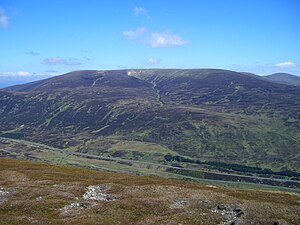A' Bhuidheanach Bheag: Difference between revisions
Created page with '{{Infobox hill |name=A' Bhuidheanach Bheag |county 1=Inverness-shire |county 2=Perthshire |range=Drumochter Hills |SMC=5 |picture=A_Bhuidheanach_Beag_from_Sow.jpg |picture captio…' |
mNo edit summary |
||
| Line 43: | Line 43: | ||
{{reflist}} | {{reflist}} | ||
{{DEFAULTSORT:A Bhuidheanach Bheag}} | |||
{{Munro}} | {{Munro}} | ||
Revision as of 21:59, 16 October 2014
| A' Bhuidheanach Bheag | |||
| Inverness-shire, Perthshire | |||
|---|---|---|---|
 A' Bhuidheanach Bheag across the Pass of Drumochter | |||
| Range: | Drumochter Hills | ||
| Summit: | 3,071 feet NN660776 | ||
A' Bhuidheanach Bheag is a mountain of the Drumochter Hills on the border of Inverness-shire with Perthshire. It reaches a height of 3,071 feet at its summit, and so it qualifies as a Munro. The mountain is on the eastern side of the Pass of Drumochter, some 15 miles west of Blair Atholl.
Its name is Gaelic for "Little Yellow Place".
The mountain has a subsidiary top named Glas Mheall Mòr ("Big Blue Hill") at NN680769 which reaches 3,044 feet and is listed as a Munro top.
Overview
The high ground to the east side of the Pass of Drumochter takes the form of a huge undulating plateau, with an average height of over 2,500 feet, which stretches northeast for 13 miles to Loch an t-Seilich in the Gaick Forest. This area is often dismissed as uninteresting countryside, however it does contain two Munros which draws many walkers to the locale.
A' Bhuidheanach Bheag lies to the southern end of the plateau and when viewed from the A9 road it shows many shallow ravines and gullies. The actual summit is out of sight from the A9 being sited back from the edge of the plateau. The rolling nature of the terrain makes A' Bhuidheanach Bheag a good hill for ski mountaineering.[1][2]
Despite its understated reputation, A' Bhuidheanach Bheag does offer the walker the feeling of space and the wide open skies of the high Grampian mountains. Its gentle curving slopes have much wildlife with Dotterel, Ptarmigan, Grouse and Mountain Hare seen on a regular basis.
The hill's name, meaning "Little Yellow Place", is thought to refer to the coarse yellow grass which grows on its slopes. The "Little" part of the name is slightly confusing as the hill is the highest point on the southern part of the plateau but demonstrates that the hill was named from how it looked from the valley not by its subjective altitude.[3]
Geography and geology
A' Bhuidheanach Bheag's best geographical feature is the remote corrie known as Cama Choire, on the eastern side of the mountain. This is a steep sided valley which cuts deeply into the hill and is drained by the Allt a' Chama Choire. The corrie is well seen from the hill of An Dun above the Gaick Pass.[3]
From a geological point of view the most interesting characteristic of the mountain is Coire Mhic-sith on its south-western flank. The corrie is a deeply incised, fault-guided valley which has received the attention of geologists, especially the School of Geoscience at the University of Edinburgh who have concluded that the presence of glacial silt and sand in the valley along with a glacial spillway to the adjacent valley of the Edendon Water means that the coire had a large ice dammed lake during the last Ice age. This Proglacial lake drained away when the ice melted but has left evidence similar, but on a lesser scale, to the "parallel roads" in Glen Roy.[4]
The summit of the mountain is a gentle rise on the plateau and is only made obvious by the presence of an OS trig point. There are occasional quartzite outcrops across the summit plateau and some of the boulders have been collected to surround the trig point, a few iron fence post have also been included. The OS map also shows a 936 metre spot height, half a kilometre to the west of the recognised summit. The summit is crossed by a line of old rusting boundary fence posts and these lead unerringly to the adjoining Munro of Càrn na Caim which lies 3 miles to the north across a boggy col with a height of 2,707 feet.
A' Bhuidheanach Bheag has two subsidiary tops over 3,000 feet in height:
Glas Mheall Mòr (3,045 feet), a mile and half to the east, is a Top in the current edition of Munro's Tables. Meall a' Chaorainn (3,005 feet) is a mile to the west of the summit and was deleted from the tables in 1981.[5]
Ascents
A' Bhuidheanach Bheag is usually climbed from the A9 road, there are two possible starting points, Balsporan Cottages (NN627791) or a mile to the north at the foot of Coire Chuirn. A more interesting route starts from the secluded country to the east at the ruined Sronphadruig Lodge and ascends by the Cama Choire to reach the plateau. Many walkers will continue to the adjacent Munro of Càrn na Caim, the plateau is quite featureless and a map and compass is necessary in misty conditions.
References
- ↑ "The Munros (SMC Guide)", Donald Bennett (editor) et al., ISBN 0-907521-13-4 Page 89 Gives mountain description and routes.
- ↑ "The Munros, Scotland's Highest Mountains", Cameron McNeish, ISBN 1-84204-082-0 Page 91 Gives general mountain description and states it is a good ski mountaineering hill.
- ↑ 3.0 3.1 "Hamish's Mountain Walk", Hamish Brown, ISBN 1-898573-08-5 Page 155
- ↑ University of Edinburgh (School of Geosciences.) Gives information on Coire Mhic-sith geology.
- ↑ Database of British and Irish Hills
| Munros in SMC Area SMC Section 5 - Loch Rannoch to Drumochter |
|---|
|
A' Bhuidheanach Bheag • A' Mharconaich • Beinn Udlamain • Carn na Caim • Geal Charn • Meall Chuaich • Sgairneach Mhòr |